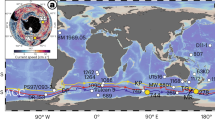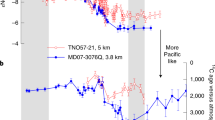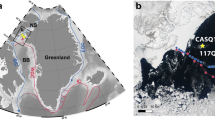Abstract
The glacial climate system transitioned rapidly between cold (stadial) and warm (interstadial) conditions in the Northern Hemisphere1. This variability, referred to as Dansgaard–Oeschger variability2, is widely believed to arise from perturbations of the Atlantic Meridional Overturning Circulation3,4,5. Evidence for such changes during the longer Heinrich stadials has been identified, but direct evidence for overturning circulation changes during Dansgaard–Oeschger events has proven elusive6. Here we reconstruct bottom water [CO32−] variability from B/Ca ratios of benthic foraminifera and indicators of sedimentary dissolution, and use these reconstructions to infer the flow of northern-sourced deep water to the deep central sub-Antarctic Atlantic Ocean. We find that nearly every Dansgaard–Oeschger interstadial is accompanied by a rapid incursion of North Atlantic Deep Water into the deep South Atlantic. Based on these results and transient climate model simulations7, we conclude that North Atlantic stadial–interstadial climate variability was associated with significant Atlantic overturning circulation changes that were rapidly transmitted across the Atlantic. However, by demonstrating the persistent role of Atlantic overturning circulation changes in past abrupt climate variability, our reconstructions of carbonate chemistry further indicate that the carbon cycle response to abrupt climate change was not a simple function of North Atlantic overturning.
This is a preview of subscription content, access via your institution
Access options
Subscribe to this journal
Receive 12 print issues and online access
$259.00 per year
only $21.58 per issue
Buy this article
- Purchase on Springer Link
- Instant access to full article PDF
Prices may be subject to local taxes which are calculated during checkout



Similar content being viewed by others
References
Völker, A. H. J. et al. Global distribution of centennial-scale records for Marine Isotope Stage (MIS) 3: A database. Quat. Sci. Rev. 21, 1185–1212 (2002).
Dansgaard, W. et al. Evidence for general instability of past climate from a 250-kyr ice-core record. Nature 364, 218–220 (1993).
Ganopolski, A. & Rahmstorf, S. Rapid changes of glacial climate simulated in a coupled climate model. Nature 409, 153–158 (2001).
EPICA Community Members One-to-one coupling of glacial climate variability in Greenland and Antarctica. Nature 444, 195–198 (2006).
Broecker, W. S., Bond, G., Klas, M., Bonani, G. & Wolfli, W. A salt oscillator in the glacial Atlantic? 1. The concept. Paleoceanography 5, 469–477 (1990).
Lynch-Stieglitz, J. et al. Muted change in Atlantic overturning circulation over some glacial-aged Heinrich events. Nature Geosci. 7, 144–150 (2014).
Menviel, L., Timmermann, A., Friedrich, T. & England, M. H. Hindcasting the continuum of Dansgaard–Oeschger variability: Mechanisms, patterns and timing. Clim. Past 10, 63–77 (2014).
North Greenland Ice Core Project Members High-resolution record of Northern Hemisphere climate extending into the last interglacial period. Nature 431, 147–151 (2004).
Skinner, L. C., Elderfield, H. & Hall, M. in Ocean Circulation: Mechanisms and Impacts (eds Schmittner, A., Chiang, J. C. H. & Hemming, S. R.) 197–208 (Geophysical Monograph Series, American Geophysical Union, 2007).
Deplazes, G. et al. Links between tropical rainfall and North Atlantic climate during the last glacial period. Nature Geosci. 6, 213–217 (2013).
Stocker, T. F. & Johnsen, S. J. A minimum thermodynamic model for the bipolar seesaw. Paleoceanography 18, 1087 (2003).
Schmittner, A., Saenko, O. A. & Weaver, A. J. Coupling of the hemispheres in observations and simulations of glacial climate change. Quat. Sci. Rev. 22, 659–671 (2003).
Timmermann, A., Gildor, H., Schulz, M. & Tziperman, E. Coherent resonant millennial-scale climate oscillations triggered by massive meltwater pulses. J. Clim. 16, 2569–2585 (2003).
Skinner, L. C., Fallon, S., Waelbroeck, C., Michel, E. & Barker, S. Ventilation of the deep Southern Ocean and deglacial CO2 rise. Science 328, 1147–1151 (2010).
Gottschalk, J., Skinner, L. C. & Waelbroeck, C. Contribution of seasonal sub-Antarctic surface water variability to millennial-scale changes in atmospheric CO2 over the last deglaciation and Marine Isotope Stage 3. Earth Planet. Sci. Lett. 411, 87–99 (2015).
Yu, J., Elderfield, H. & Piotrowski, A. M. Seawater carbonate ion- δ13C systematics and application to glacial–interglacial North Atlantic ocean circulation. Earth Planet. Sci. Lett. 271, 209–220 (2008).
Yu, J. & Elderfield, H. Benthic foraminiferal B/Ca ratios reflect deep water carbonate saturation state. Earth Planet. Sci. Lett. 258, 73–86 (2007).
Berger, W. H. Planktonic foraminifera: Selective solution and paleoclimatic interpretation. Deep-Sea Res. I 15, 31–43 (1968).
Barker, S. & Diz, P. Timing of the descent into the last ice age determined by the bipolar seesaw. Paleoceanography 29, 489–507 (2014).
Charles, C. D., Lynch-Stieglitz, J., Ninnemann, U. S. & Fairbanks, R. G. Climate connections between the hemisphere revealed by deep sea sediment core/ice core correlations. Earth Planet. Sci. Lett. 142, 19–27 (1996).
Piotrowski, A. M., Goldstein, S. L., Hemming, S. R. & Fairbanks, R. G. Temporal relationships of carbon cycling and ocean circulation at glacial boundaries. Science 307, 1933–1938 (2005).
Hodell, D. A., Charles, C. D. & Sierro, F. J. Late Pleistocene evolution of the ocean’s carbonate system. Earth Planet. Sci. Lett. 192, 109–124 (2001).
Hemming, S. R. Heinrich events: Massive late Pleistocene detritus layers of the North Atlantic and their global climate imprint. Rev. Geophys. 42, RG1005 (2004).
Timmermann, A., Krebs, U., Justino, F., Goosse, H. & Ivanochko, T. Mechanisms for millennial-scale global synchronization during the last glacial period. Paleoceanography 20, PA4008 (2005).
Goodman, P. J. Thermohaline adjustment and advection in an OGCM. J. Phys. Oceanogr. 31, 1477–1497 (2001).
Dong, B.-W. & Sutton, R. T. Adjustment of the coupled ocean–atmosphere system to a sudden change in the Thermohaline Circulation. Geophys. Res. Lett. 29 http://dx.doi.org/10.1029/2002GL015229 (2002).
Ahn, J. & Brook, E. J. Siple Dome ice reveals two modes of millennial CO2 change during the last ice age. Nature Commun. 5, 3723 (2014).
Schmittner, A., Brook, E. J. & Ahn, J. in Ocean Circulation: Mechanisms and Impacts Vol. 173 (eds Schmittner, A., Chiang, J. C. H. & Hemming, S. R.) 209–246 (Geophysical Monograph Series, American Geophysical Union, 2007).
Menviel, L., England, M. H., Meissner, K. J., Mouchet, A. & Yu, J. Atlantic-Pacific seesaw and its role in outgassing CO2 during Heinrich events. Paleoceanography 29, 58–70 (2014).
Köhler, P., Joos, F., Gerber, S. & Knutti, R. Simulated changes in vegetation distribution, land carbon storage, and atmospheric CO2 in response to a collapse of the North Atlantic thermohaline circulation. Clim. Dynam. 25, 689–708 (2005).
Reimer, P. J. et al. IntCal13 and Marine13 radiocarbon age calibration curves 0–50,000 years cal BP. Radiocarbon 55, 1869–1887 (2013).
Barker, S. et al. Interhemispheric Atlantic seesaw response during the last deglaciation. Nature 457, 1097–1102 (2009).
Lewis, E. & Wallace, D. W. R. Program developed for CO2 system calculations (Carbon Dioxide Information Analysis Center, Oak Ridge National Laboratory, US Dept. of Energy, 1998).
Le, J. & Shackleton, N. J. Carbonate dissolution fluctuations in the western equatorial Pacific during the late Quaternary. Paleoceanography 7, 21–42 (1992).
Jouzel, J. et al. Orbital and millennial Antarctic climate variability over the past 800,000 years. Science 317, 793–796 (2007).
Veres, D. et al. The Antarctic ice core chronology (AICC2012): An optimized multi-parameter and multi-site dating approach for the last 120 thousand years. Clim. Past 9, 1733–1748 (2013).
Ninnemann, U. S., Charles, C. D. & Hodell, D. A. in Mechanisms of Global Climate Change at Millennial Time Scales Vol. 112 (eds Clark, P. U., Webb, R. S. & Keigwin, L. D.) 99–112 (American Geophysical Union, 1999).
Acknowledgements
We are indebted to D. Hodell for his insightful comments. J.G. was funded by the Gates Cambridge Trust. L.C.S. would like to acknowledge NERC grant NE/J010545/1 and the Royal Society. S.M. was supported by ERC grant 2010-NEWLOG ADG-267931 HE. C.W. acknowledges support from the European Research Council grant ACCLIMATE/no 339108. L.M. was supported by the Australian Research Council grant DE150100107. A.T. acknowledges support from the US NSF (grants 1400914, 1341311). Model experiments were performed on a computational cluster owned by the Faculty of Science of the University of New South Wales, Australia. This is LSCE contribution 5353 and IPRC publication number 1131.
Author information
Authors and Affiliations
Contributions
J.G. and L.C.S. designed the study. C.W. collected the core material. J.G. performed census counts and measured the epibenthic trace element composition under the guidance of S.M. at the University of Cambridge. J.G. and L.C.S. analysed the proxy data. L.M. and A.T. contributed model output data and the interpretation thereof. J.G., L.C.S. and A.T. wrote this manuscript with contributions from all authors.
Corresponding author
Ethics declarations
Competing interests
The authors declare no competing financial interests.
Supplementary information
Supplementary Information
Supplementary Information (PDF 3120 kb)
Rights and permissions
About this article
Cite this article
Gottschalk, J., Skinner, L., Misra, S. et al. Abrupt changes in the southern extent of North Atlantic Deep Water during Dansgaard–Oeschger events. Nature Geosci 8, 950–954 (2015). https://doi.org/10.1038/ngeo2558
Received:
Accepted:
Published:
Issue Date:
DOI: https://doi.org/10.1038/ngeo2558
This article is cited by
-
Millennial atmospheric CO2 changes linked to ocean ventilation modes over past 150,000 years
Nature Geoscience (2023)
-
Orbital- and millennial-scale Antarctic Circumpolar Current variability in Drake Passage over the past 140,000 years
Nature Communications (2021)
-
Decreasing predictability as a precursor indicator for abrupt climate change
Climate Dynamics (2021)
-
An ice–climate oscillatory framework for Dansgaard–Oeschger cycles
Nature Reviews Earth & Environment (2020)
-
Southern Ocean convection amplified past Antarctic warming and atmospheric CO2 rise during Heinrich Stadial 4
Communications Earth & Environment (2020)



